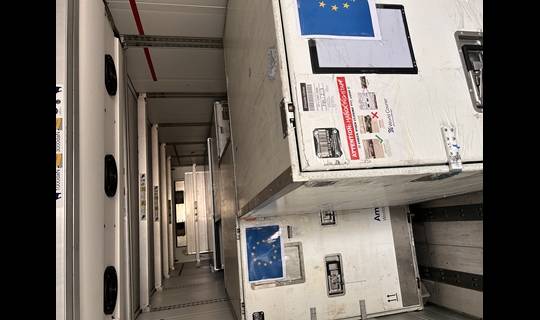Navigating the next pandemic: A roadmap for resilient supply chains
By Paula Pulsoni
In 2020, the COVID-19 pandemic highlighted global medical supply chain vulnerabilities. To prepare for future pandemics, the pharmaceutical industry must learn from past challenges and proactively strengthen supply chain resilience1.
In this article, Paula Pulsoni, Vice President, Sales and Services at World Courier, explores the critical importance of resilient medical supply chains in mitigating the impact of future outbreaks. Drawing upon lessons learned from COVID-19, Pulsoni emphasizes the need for a holistic approach to pandemic preparedness, with a particular emphasis on robust logistics systems.

The evolving threat landscape

In recent years, the infectious disease diagnostics market has grown rapidly. This has been fueled by the increasing prevalence of infectious diseases worldwide, with climate change a significant driver of emerging and re-emerging infectious diseases2, 3.
Rising global temperatures, shifting weather patterns, and environmental changes are allowing disease-carrying vectors to thrive in new regions, leading to the spread of diseases to areas where they were previously uncommon4, 5, 6. These include:
- Dengue fever
- Zika
- Chikungunya
- Malaria
- Coronaviruses
As a result, severe public health challenges are emerging, particularly in regions lacking the necessary infrastructure and resources to effectively diagnose, treat, and contain these diseases7, 8. Addressing these climate-driven threats requires increased investment in infectious disease research, surveillance, and diagnostic capabilities. It will also necessitate international collaboration and comprehensive preparedness strategies, including resilient medical supply chains to ensure the timely distribution of countermeasures during outbreaks.
Enabling a rapid response
An effective infectious disease pandemic response hinges on the ability to rapidly detect and contain emerging infections. Establishing robust surveillance networks, both at the national and global levels, is crucial for early identification of potential threats. This involves investing in advanced diagnostic capabilities, genomic sequencing technologies, and data-driven monitoring systems to track the spread of pathogens in real time.
Resilient logistics systems are integral to effective surveillance, ensuring the timely transportation of samples and test kits to and from remote areas. Implementing targeted interventions once a threat is detected and swiftly mobilizing medical resources such as personal protective equipment (PPE), therapeutics, and vaccines requires:
- Streamlined decision-making processes
- Well-coordinated response strategies
- Ability to rapidly expand production and distribution of essential medical supplies.
Logistics providers can ensure the seamless coordination of these factors to maintain an agile and responsive network capable of detecting and containing emerging infectious disease threats before they escalate into widespread pandemics.
How global logistics providers are helping to fight future pandemics
In the face of a new pandemic, relying on the right logistics providers is critical to maintaining uninterrupted supply chains for essential medical goods. Logistics providers with specialized expertise in healthcare applications will understand the unique challenges and stringent requirements involved in distributing vital supplies during a crisis, including the need for:
- Temperature control
Robust temperature-controlled transportation and storage capabilities are needed to maintain the integrity and efficacy of temperature-sensitive products, such as vaccines and biologics. Improper handling could render these critical supplies ineffective, negatively impacting pandemic mitigation efforts. - End-to-end tracking
Advanced tracking and monitoring systems ensure end-to-end visibility and real-time supply chain intelligence. This allows for rapid identification and resolution of bottlenecks or disruptions that could delay the delivery of life-saving medical countermeasures to affected regions. - Disruption mitigation strategies
Contingency planning and risk mitigation strategies are needed to maintain the continuity of operations and navigate disruptions such as border closures, transportation restrictions, or production delays. This ensures an uninterrupted flow of medical supplies during a public health crisis. - Regulatory adherence
Regulatory compliance and adherence to stringent quality standards across all touchpoints are non-negotiable when dealing with medical products. Any lapses could compromise their safety and efficacy, undermining pandemic response efforts. - Rapid adaptability
Scalability and agility to rapidly adapt to fluctuating demand and evolving logistical requirements are vital during a pandemic, as medical supply needs can change drastically and unexpectedly based on the disease’s spread and severity.
By partnering with logistics providers specializing in these critical areas, public health authorities and pharmaceutical companies can build resilient supply chains capable of effectively distributing medical countermeasures when and where they are needed most.
The importance of data-driven insights
As part of a pandemic preparedness strategy, partnering with a provider that not only understands the unique requirements of healthcare logistics but also leverages data analytics is critical.
In the era of big data and digital transformation, advanced analytics and data-driven insights are building more resilient medical supply chains capable of responding effectively to pandemic threats. By harnessing the power of data, these logistics providers can:
- Enhance visibility and mitigate risk
Gain real-time visibility into inventory levels, demand patterns, and potential supply chain disruptions, enabling proactive contingency planning and risk mitigation strategies. - Better manage inventory
Optimize inventory management and distribution strategies to minimize stockouts, reduce waste, and ensure the efficient use of limited resources during public health emergencies. - Forecast demand to scale up
Employ predictive modeling and forecasting techniques to anticipate surges in demand for PPE, therapeutics, and vaccines, allowing organizations to proactively scale operations. - Identify vulnerabilities
Spot potential points of failure within the supply chain, facilitating data-driven decision-making and continuous improvement through performance monitoring and analysis. - Optimize routes
Optimize transportation routes to minimize fuel consumption and emissions, involving factors such as identifying the most efficient routes, consolidating shipments, and minimizing empty miles.
Coupled with robust surveillance and response capabilities, data-driven supply chains form a critical component of comprehensive pandemic preparedness strategies.
A logistic provider to help you prepare for the next health crisis
As the world continues to face the threat of infectious diseases, ensuring reliable medical supply chains is paramount. Logistics providers specializing in healthcare understand the unique requirements of the industry and leverage data and technology to optimize processes. This includes real-time tracking, demand forecasting, and identifying potential vulnerabilities, ensuring that life-saving medicines and supplies reach their destinations efficiently.
By partnering with providers like World Courier who are well-equipped to provide resilient logistical support in the face of future outbreaks, biopharma companies can proactively address potential disruptions and safeguard product integrity. These collaborations are essential investments in global health preparedness, ensuring that critical medical supplies are readily available when needed most.
Discover how we can support the development of your pandemic preparedness strategy. Contact us now.
References
1Fernandes, G., Hassan, I., & Sridhar, D. (2022). Building resilient health-care supply chains to manage pandemics in low- and middle-income countries. Bulletin of the World Health Organization, 100(5), 306-308. https://www.ncbi.nlm.nih.gov/pmc/articles/PMC8795856/
2https://www.phe.gov/Preparedness/legal/Documents/National-Strategy-for-Resilient-Public-Health-Supply-Chain.pdf
3 https://www.marketsandmarkets.com/Market-Reports/infectious-disease-diagnostics-market-116764589.html
4Mojahed N, Mohammadkhani MA, Mohamadkhani A. Climate Crises and Developing Vector-Borne Diseases: A Narrative Review. Frontiers in Public Health. 2023;11. https://www.ncbi.nlm.nih.gov/pmc/articles/PMC9874214/
5Semenza JC, Rocklöv J, Ebi KL. Climate Change and Cascading Risks from Infectious Disease. Infect Dis Ther. 2022;11:1371-1390. https://link.springer.com/article/10.1007/s40121-022-00647-3
6Beyer, R. M., Manica, A., & Mora, C. (2021). Shifts in global bat diversity suggest a possible role of climate change in the emergence of SARS-CoV-1 and SARS-CoV-2. Science of the Total Environment, 767, 145413.
7Rocklöv, J., & Dubrow, R. (2020). Climate change: an enduring challenge for vector-borne disease prevention and control. Nature Immunology, 21(5), 479-483.
8Watts N, Amann M, Arnell N, et al. The 2020 report of the Lancet Countdown on health and climate change: responding to converging crises. Lancet. 2021;397(10269):129-170. https://www.thelancet.com/journals/langlo/article/PIIS2214-109X(21)00442-3/fulltext





